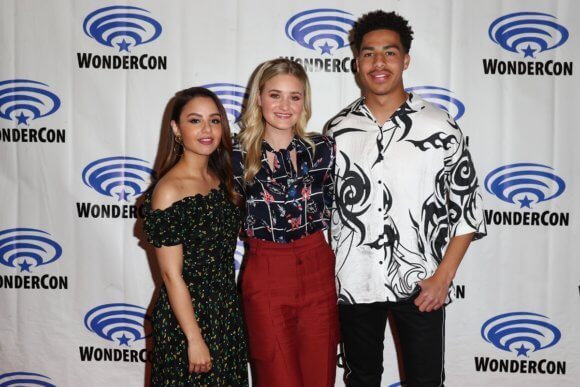Dreamworks’ She-Ra and the Princesses of Power creator Noelle Stevenson and the voice of She-Ra herself, Aimee Carrero, were at WonderCon for a panel on their show’s second season. The Netflix animated series reintroduced the female warriors of Etheria with a modern-day feminist twist.
Adora still inherits the mantle of She-Ra, whom she can become with her magic sword and chanting, “For the honor of Grayskull,” but now she is a vulnerable, uncertain leader. Her friends are now a diverse group of allies who have their own perspectives on doing battle, and they all have their own lessons to learn. Stevenson discussed the adaptation and some changes coming to the second season, and we even got Carrero to say She-Ra’s famous line.
She-Ra and the Princesses of Power season two premieres on April 26, 2019 on Netflix.
What’s your favorite episode for season two?
Noelle Stevenson: “The D&D episode is definitely it for me. I’m really excited for people to see that one. It’s a special one.”
Aimee Carrero: “I think the reason it’s so special is because we all get to step outside of our characters in a way which is always super fun. And you give me so many opportunities to do that as Adora.”
Noelle Stevenson: “I love it so much. I mean, you’re the one who created Adora, basically. I remember we were like, ‘How do we bring this character to life?’ Then you just read it and I was like, ‘There she is! It’s Adora…oh my god!’”
Aimee Carrero: “That’s incredibly kind. But I think that’s what’s so great about Adora is that it’s the first time she’s experiencing anything. Like, she’s never had a birthday before; she’d never seen a horse before. So, it’s a really good character to experience things for the first time – like go to a prom or, you know, play D&D. It’s really cool. That was my favorite, too.”
The first season was so good at incorporating some really good morals for the viewer without sacrificing the story. How were you able to do that in season two and what sort of lessons can we expect?
Noelle Stevenson: “I think what we try to do is the original show was known for the characters turning to camera and saying, ‘Also, remember the rain forest is in danger.’ We wanted to pay homage to that same societal lens without necessarily turning to the camera delivering the moral in that way. But like laying out the complexities of life and the complexities of our society and letting the viewer draw their own conclusions in some ways, but also being very clear about what we support and why.
The struggles that the characters go through are very ingrained in the core of the show. And so, we see characters not just make the right decision and become aspirational in ways that we want to emulate, we also see characters make the wrong decision in ways that we don’t want to emulate. We see them pay the consequences of that. The characters constantly have to examine themselves, their motives and their actions and see what effect they’re having on the people around them. And then we just wanted to make that more of the core of the show. Not the moral at the end of the show but something that is really at the heart of the show.”
Aimee Carrero: “I think that’s a big strength of the show. I think that’s a real strength of the show is that you do bring in a very genuine emotional core and only genuine things can spring from that if the right intention is put in.
Also, this show came about during a time of at least for me – I can speak for myself, not for Noelle – but it was a time of a lot of in my mind kind of political uncertainty. And so when I would come in and record, you know especially in the first season, episodes with like Madame Razz and she had this one line ‘there’s no more stars,’ and I was like, ‘I get that! I get it.’ And so, I think that it’s also a product of the time we’re in, this emotional uncertainty and where we fit in as women, women of color, all of that. It’s just a mess and the show is a place to put that.”
Noelle Stevenson: “It’s both an escape for us and also a way for us to express our fears, I think, in a way that’s safe. It’s just woven throughout the show. Like Adora’s entire arc as a person, as character, is about a young woman in a leadership position for the first time and how she deals with that. All the characters deal with that in their own way and it becomes about even though it’s not a world with sexism as we know it, the characters still deal with things that I think are very much the stresses and anxieties that we deal with every single day in this world.
We want to make a world that’s both an escape and like a fun place to go to get away from the real world but also one that isn’t afraid to take a look at and work through the feelings of watching what’s happening to our world, and the fear and the sadness around that.”

Were there any characters or elements from the classic series that you wanted to do in season two?
Noelle Stevenson: “I don’t know if I can give that away. There are definitely some cool new cameos coming up and then just even more on the next season.”
You’re creating this new lore of technology as magic and the legacy of She-Ra. Will we be digging more into that and possibly seeing former She-Ras?
Noelle Stevenson: “Absolutely. We’ve talked a lot about Mara, and Mara is so woven into the history of the show, and Adora is so sort of fixated on her. She has inherited the mantle from her, which I think as women we deal with a lot. You’re looking up to the women who came just a few steps before you to kind of see what you can learn. And I think that it’s part that even the women coming after us, we sort of know that they’ll go farther than we ever could. And so the feeling of getting the torch passed to her by Mara and what do I do now? How do I both avoid what happened to her and also succeed in the ways that she succeeded as well?”
Aimee Carrero: “And the hard part is that she can’t ask her. That’s one of the core things that Adora deals with this season is all the questions not only about her own identity but like what is she supposed to do with this responsibility. How is she even supposed to save anything? She doesn’t even have a blueprint. So, I think she’s sort of figuring it out. I think that’s kind of where we are in season two is figuring it out.”
How do you feel creatively about moving to these shorter seasons?
Noelle Stevenson: “I think we get to deliver episodes more often so that instead of it being for example six months between drops of episodes, they can come much more frequently. It’s a little bit more of the experience of constantly watching something instead of just like here’s 13 episodes binge them all at once and then wait for half a year before you get another one. So that’s the idea behind it. I think that it does interesting things with our episode structure where like we basically approach these stories as arcs of 13 so usually that middle divide of the season happens with a cliffhanger. So, it’ll be interesting to see what the reaction to that is. But I’m excited to get more on more often.”
Marcus Scribner mentioned his darker tone of season two. How do you do that while keeping it still She-Ra?
Noelle Stevenson: “I think that the darkness is something that’s inherent in the story where it’s like so much of season one is about setting up these power structures and setting up these characters but it’s also there’s a lot there, the conflicted feelings between the characters, the dark plot of the villains. It’s just something that we delve into more as the characters evolve and deepen.
We always try to keep it fun and keep the jokes coming, but it also sometimes can lead to pretty heartbreaking (moments). You know, a lot of our episodes would be like all fun and games until then at the end it’s like tears running down a well.”
Aimee Carrero: “Sometimes I would show up to work and it’s going to be a comedy-heavy episode and then not. It’s fun, but like this year especially.”
Noelle Stevenson: “It’s like, ‘We’re having so much fun, oh no!’”
Aimee Carrero: “That’s what I think keeps people coming back, too. People want that. People want that emotional release in every way they can get it, whether it’s laughter or tears or just frustration. There’s a reason why shows with an emotional core are succeeding right now.”
Do you do anything different with your voice when you’re She-Ra versus Adora?
Aimee Carrero: “Well, I think…do you put my voice through something for She-Ra, like a filter?”
Noelle Stevenson: “Sometimes we do for like ‘honor of Grayskull’ we put in reverb. But, no, actually, it’s pretty much the same.”
Aimee Carrero: “Because we talked about that early on. I remember that was one of my questions and you were thinking of toying with the filter. But initially, I was worried I wouldn’t have a commanding enough voice. That’s something that I worried about also because I do another show where I play a princess but it’s a very different tone. So, I was afraid it would just sound like the same person. But I think because of the character, the other character I play always comes from a place of real positivity and that’s where she leads with. I think Adora is much more complicated. The weight she feels on her shoulders naturally makes my voice a little bit in my lower register.”
Noelle Stevenson: “I also think Adora has a She-Ra voice. When she’s trying to be She-Ra – we saw her do this in season one where she’s like, ‘Yes, it is I, She-Ra!’ So much of it is that she’s inherited this power of a person that she embodies and it’s like, ‘How do I work this?’ It really does distill Adora’s voice coming out of She-Ra because so much of it was her learning how to embody that suit of armor.”
- Inside Season 2 with Marcus Scribner, Merit Leighton and Karen Fukuhara
- AJ Michalka and Lauren Ash Interview





